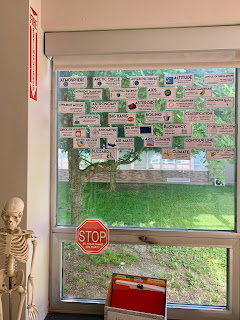Why 5 Questions at a time will do
In my high school classes I have found that when I go over too many practice questions with my students they easily lose interest. For the past couple years I have been giving my students only 5 questions at a time. We call these "Fast 5's." Over the years I have changed the way I use these.
I used to assign them as homework but I found it was too easy for the students to share the answers with one another. I would sometimes use them as an exit ticket out the door but then I had to remember to check them, hand them back, and then go over them the next day. This didn't always happen as much as I wanted. It's funny how sometimes in teaching we keep doing what we've always done even though we know it isn't as effective as it could be but we just don't know how to tweak it to make it better. Often the change that needs to be made is a tiny change but it makes a HUGE difference.
I've had a teaching revolution this year due to the pandemic. This school year I have two classes that are fully remote, and two classes that are hybrid; therefore at any one time I have no more than 12 students in my classroom. With fewer students in the classroom I have less pressure to motivate and monitor a bunch of teens at the same time and have more time to try new stuff out. I guess we can call that a silver lining to the pandemic.
This year I started reading the book Powerful Teaching and it has changed my teaching dramatically.
The book addresses four teaching strategies that are based on and supported by research. These four strategies work very well with Fast 5's. Here's a quick summary of the 4 strategies and how Fast 5's incorporate these strategies:
1. Retrieval Practice boosts learning by pulling information out of students' heads rather than cramming information into students' heads. Retrieval practice is a no stakes learning opportunity that improves student performance. The Fast 5's are rarely graded and put into the grade book. They are usually used for a quick self assessment. they also give the teacher quick feedback about which questions the students struggle with.
2. Spaced Practice boosts learning by spreading lessons and retrieval opportunities out over time so that learning isn't crammed in all at once. By returning to content every so often, students' brains have had time to rest and be refreshed. I seldom use the Fast 5's on the day that the students learn that material. I give them time to absorb the information and practice the skills before using the knowledge in a Regents question.
3. Interleaving boosts learning by mixed up closely related topics and encouraging discrimination. For example learning increases when students practice addition, subtraction, multiplication, and division problems all mixed up, rather than one type of problem at a time. The Fast 5's that have multiple units for example: 1.1 - 5.5 require the students to evaluate which part of the content knowledge is necessary to answer those questions. It adds a higher level of difficulty and makes them a bit more difficult.
4. Feedback boosts learning by giving the student the opportunity to know what they know, and know what they don't know. This enhances students' metacognition or understanding about their own learning progress. By doing only 5 questions a day the students care more about each question and are not overwhelmed by the task. Also 5 questions is very easy to score quickly for each student. I like to highlight the wrong ones and ask them to take a look at the choices again. It gives the student a low stakes review and gives them a sense of accomplishment when they struggle but can find the correct answer.
If you would like to see the Fast 5's that I have created you can find them here.
https://www.teacherspayteachers.com/Store/Funderstanding-Science




Comments
Post a Comment